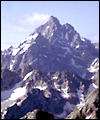Climbing the Grand Teton
A Moonlit Initiation to Guided Alpine Climbing
[Interview with Phil Powers] [Cheap Lodging] [Climbing Video]
 The Grand |
|
This is the crux pitch of the Pownall-Gilkey route on the Grand Teton and Jackson Hole Mountain Guides (JHMG) has placed the etrier to help climbers deal with rock that's often covered with ice, slapped by wind and bitterly cold. I'm on JHMG's four-day Grand Teton climber's course, designed to get anyone in reasonable shape and big on desire to the summit of the Grand. I classify myself as a recreational 5.8 climber—I'm an occasional weekend warrior; I do not spend 36 hours a day at the rock gym. The Grand is huge and I'm unfamiliar with the routes so to prevent a long summit day from becoming truly epic, a guided climb seemed the way to go.
| "I twirl back and forth as I try to insert a boot, any boot, into the twisting web stirrups. It takes minutes, an eternity on a rock pitch, to force my feet up the stirrups to easier ground..." |
| STREAMING VIDEO Climbing the Grand | |
 | |
| REALPLAYER modem speed (56k) (T1) (300k) | |
WINDOWS MEDIA modem speed (56k) (T1) (300k) | |
| To watch, download a FREE media player | |
It's 4,300 feet up to base camp over roughly eight miles and our four guides — Jennifer, Georgie, Bean and Andy — start us off at a slow pace. I'm soon breathing heavily but it's not out of control or anything, I can still hike and talk. Several hours later, we're at the meadows, elevation 9,000 feet, where many non-guided climbers attempting the Grand pitch their tents. We keep marching upwards and as the air thins even more, our group spreads out over the trail. At 11,000 feet, and with commanding views of Garnet Canyon and the Middle Teton, JHMG base camp is situated amidst boulders and underneath soaring granite walls. I can imagine hanging here for three days while I acclimate and climb.
Day two is spent practicing climbing and rappelling multipitch routes. I brought my own belay device, but I really wish I had also brought my own harness. JHMG's harnesses lacked detachable leg loops, making...uh...calls of nature problematic. The guides have split us up into groups of two and three which will stay together throughout the summit assault. Team Florida (Dave, Brian and Mack) climbs together as do the two Manhattanites (Howard and Rich). I'm paired with the Ottawan, Erick, and Jennifer takes charge of our duo. We end the climbing practice with a boulder problem, easily 5.10 or greater, and Erick, who hasn't climbed much before, smears it in his combat boots.
 The Crux Pitch |
|
Knowing exactly where to go in the darkness, Jennifer guides us relentlessly upwards. I'm sucking big air and I still can't seem to get enough. I listen for Erick and Jennifer's breathing but I can't hear anything. Okay, so they're not breathing. Still, it's surreal to climb rock touched by moonlight.
| "Jennifer points out that we're sharing the summit with Alex Lowe. We chat with Alex while Erick and I take photos..." |
We're blessed with ideal weather; there's no wind, the sky is clear, and it's too warm for ice to have formed. Above the crux, the climbing eases to 5.6 and soon Jennifer has us traversing 3rd and 4th class rock to the Owen-Spalding route. I'm not even paying attention when we hit the summit, six hours after we left camp.
 Summit Social |
|
But all too soon, we too are winding our way down to the rappel station. One double rope free rappel gets us back to the start of the Pownall-Gilkey route and we downclimb to the Lower Saddle. Having ascended by headlamp, it would be easy to choose the wrong gulley on the descent but Jennifer gets us back to the Saddle in three hours. The still air is toasty warm and we stop for a bit of horizontal rest — very brief because the brown, barren ground has soaked the heat like Saharan sand. We continue down.
That boulder strewn slope we initially descended in darkness now looms like Everest. I pound, well, more like creep, upwards to reach camp, 14 hours after I had left it. Once back, Team Battan Death March, those wild and crazy Manhattanites, greets us. Its fearless leader, Bean, apparently didn't get enough of a workout on the Grand and recruits fellow guide Andy to climb another nearby multipitch route. They return at sunset.
The last team back to camp is the Florida trio. We all dine, swap summit stories, and head to our tents. It's 7pm and not too early to become unconscious. The hike out on day four is, of course, anticlimactic. The clouds are rolling in so we hike down —back to the concrete, wired world.
I have to admit that prior to this trip, I strongly believed in earning summits on my own, without guides. I'm a convert now and would climb again with JHMG. Extra bonus: they supply all the meals (breakfast, lunch, dinner, snacks) for these four-day courses, and climbing gear, sleeping bags, mattresses, and tents. Sweet.
— Sara Machlin, MountainZone.com Staff
For more info, email JHMG.

